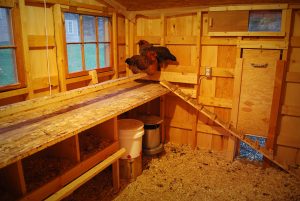Housing Your Pullets: Four Options and Other Considerations
By Richard Brzozowski, Poultry Specialist, University of Maine Cooperative Extension, richard.brzozowski@maine.edu

Housing Options for Your Small Flock
Following are four possible options for housing your hens. The appropriate option will be determined by your situation. This housing ought to be ready well before you obtain the pullets. Hens require about 3 square feet per bird. This amount of space allows for them to live without being stressed.
- Use an existing hen house or outbuilding designed for poultry.
- Use a portion of an existing structure such as a barn, garage or outbuilding and make changes by constructing a room or pen to keep poultry by building a suitable size pen.
- Build a poultry house of suitable size and in a suitable location.
- Build a temporary facility such as a chicken tractor with nesting boxes. Move birds to a more permanent structure before November for the winter.
Poultry Housing Principles
Any structure you keep your chickens will need to consider the following principles:
- Space: Provide adequate space for the number of birds you will keep. Birds require 2 to 3 square feet per bird. They need space to move about, to get away from bossy hens, and to be comfortable (stress-free). This space could include an outside run.
- Protection from the elements: Chickens can be stressed by the weather in any season. Winter is probably the hardest season for poultry with freezing temperatures and cold winds. Plan your poultry house to keep your birds comfortable. The house’s walls, ceiling, and floor can be insulated to help the unit hold heat and keep out the cold.
- Air exchange: Good ventilation is important for the health and comfort of the birds. Ventilation can be provided naturally or with an intake/exhaust fan. You will know when the air in your chicken house or pen is bad as it will smell of ammonia and possibly sting your eyes. Don’t let ammonia levels get to this point.
- Bedding: Provide pine shavings as bedding to keep your hens clean and comfortable. If bedding gets wet (especially around the waterer), remove the wet bedding and replace the area with dry shavings. Cleaning out a pen entirely is typically done two times a year.
- Easy to clean: Design your hen house for easy cleaning. This might involve a wall that can be removed or a wide door for wheel barrel entry/exit. The floor ought to be smooth for easy scraping.
- Nesting boxes: provide at least 1 nesting box for every 5 birds. These boxes ought to be bedded with a deep layer of pine shavings unless they are designed as “roll-out” boxes. For bedded nest boxes, clean them out and replace the bedding when they get soiled. Clean nest box bedding helps keep eggs clean.
- Roosting: Birds sleep on a perch or in the roosting position. Provide ample space for all birds to roost at the same time. Wood makes a good perch.
- Water: Your birds must have access to clean fresh water at all times. Water can be provided with portable watering units or through a watering system with drinking cups or nipples. Make sure all birds have access to drinking water by situating it at the proper height and providing an adequate number of waterers.
- Protection from predators: The structure in which you keep your hens ought to be designed to keep predators out. Predators can be carnivores like foxes, coyotes, raccoons, skunks, and weasels or be winged like hawks.
- Light: Natural light is good for hens and windows allow for natural light in the hen house. However, light will need to be provided in the winter months when natural day length is limited.
- Electricity: Electrical power can make keeping poultry easier. Electricity to power a timed lighting system or to power a heated watering base can save time and help with the comfort of the chickens.
